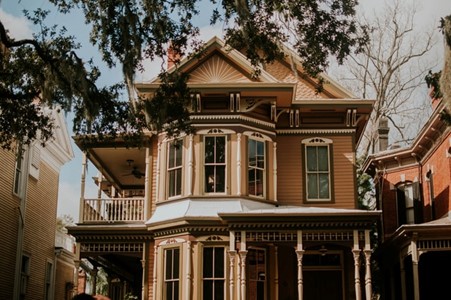Buddy Schum of Bucks County is a historical restoration consultant who has worked on several Victorian home renovation projects in Bucks and Carbon County, PA. In the article below, Buddy Schum discusses the approach to tackling one of the projects and some considerations that DIYers and contractors alike need to keep in mind.
Living in a Victorian house is often like living in a time capsule.
What makes it so charming and quirky – the overabundance of wood, the heavy marble, the decorative turrets – is now what Buddy Schum of Bucks County says makes it seem outdated and cold. The compartmentalized rooms that were once in style now cry out to be turned into wide-open spaces.
Renovating a Victorian house is both rewarding and daunting – and entirely doable. The reward according to Buddy Schum: residing in a home of arresting beauty you love while giving it the lift it needs for the 21st century.
Buddy Schum Defines “Victorian” homes
Buddy Schum explains that the Victorian era refers to the period of Queen Victoria’s reign over Great Britain from 1836 to 1901. It was a time of modernization, particularly in scientific and medical understanding, industrial advances, and social expansion to include a leisure class or middle class.
As early as the 1840s, Victorian homes began popping up in the United States. At first, they were mostly Italianate in style, with wide eaves, ornamental brackets, low roofs, and cupolas.
As the era went on, Victorian homes took on a more Gothic look, with such elements as diamond-shaped windowpanes, striking arches, and pointy windows. Such so-called Gothic revival homes still stand throughout America.
There were further Victorian spinoffs according to Buddy Schum of Carbon County, including Queen Anne Victorian looks with larger porches and rounded towers, folk Victorian, a sort-of generic Victorian that adds some Gothic-esque characteristics to a standard home, and the so-called Second Empire style with trademark mansard roofs and ornate dormers.
Things to Consider Before Renovating or Remodeling a Victorian Home
While Victorian homes were perfect reflections of the sensibility and needs of the time, they don’t quite meet the needs of their modern inhabitants. Rooms are often small and closed off, heavy woods create dark and somewhat foreboding and the floorplans are, well, very odd for lack of a better word.
Before the renovation, Buddy Schum says to be sure to keep in mind that Victorian interior walls are frequently load-bearing so it may not be easy and cheap to create open floor plans.
To retain the character of the home while making some modern updates at the same time, replacement items, such as period roof slates, bricks, and window design items tend to be expensive. Repairing a roof or adding a new roof and replacing or fixing the door both come with high prices as well.
Common Aspects of Victorian House Renovations
- Plasterwork: Buddy Schum says some stains can easily be removed using a homemade mixture of bleach and water, but much of the plasterwork in Victorian homes is covered by decades of paint layers. Stripping nit back to repair it properly is often required
- Masonry: is subject to incorrect or uneven plasterwork and internal walls are often the place owners start with their Victorian house renovations. To prevent dampness and to ensure the right materials are used, consider hiring a reputable plasterer.
- Electrical issues: Perhaps not surprisingly, electric issues abound in Victorian homes. They are typically in need of a structural upgrade every 5 to 10 years, including the installation of fire alarms and different types of smoke detectors.
- Insulation: Buddy Schum explains that the sash windows of Victorian homes are distinctive and lovely and not at all energy efficient. Insulation was also an afterthought for many Victorian homes. That’s why renovators typically include insulation upgrades, improving ventilation, and making doors and windows draft-poof.
Renovation Steps:
- Work on a budget: Home renovations, especially the complex renovations involved with Victorian homes, require a detailed budget. Be sure to write out as many details as you can, along with the cost estimates of each renovation item before you begin.
- Pick a Desired Flow: It’s not enough to just desire an “open concept” according to Buddy Schum. Victorian homes are full of quirky layouts, rooms, and decorative elements, so along with your detailed budget, created a detailed layout plan for a renovated home.
3. Settle on Design Features: Those who live in Victorian homes usually appreciate all the special details that make it unique. It is possible to retain or even add to those details during a renovation. You may even want to bring a design feature back that was eliminated by a previous owner.
4. Comparison shop: There are two things you can rely on with home renovations: It will take be more expensive and take longer than planned. In addition to creating a preferred and realistic timeline of your renovation, it pays to comparison shop for materials, everything from tiles to wood to doors and fixtures.
In the end, Buddy Schum of Bucks County reminds that the goal will be to hopefully retain the arresting beauty, uniqueness and charm of a Victorian but infused with tweaks to make it suitable for modern life.







